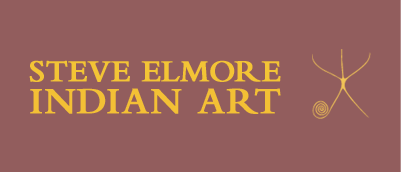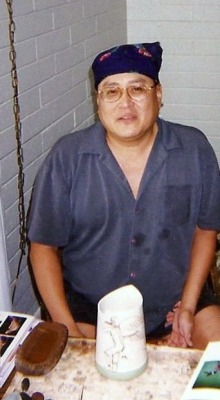Nathan Begaye (1958-2010)
Nathan Begaye (1958-2010) was a Navajo and Hopi artist known for his pottery. He worked in a variety of natural colors on white, yellow, orange, red, and green, and made bowls, jars, and other forms. Begaye’s favorite designs were parrots, serpents, human faces, feathers, and rain clouds. While he drew inspiration from both Hopi and Navajo traditions, and researched them extensively, his multi-cultural background also allowed him the freedom to experiment aesthetically while still utilizing traditional methods of pottery-making. As Gregory Schaaf observes, “Perhaps Nathan Begaye’s mixed Navajo and Hopi ancestry freed him from maintaining family stylistic traditions. This may account for his diversity of styles. His pottery stands on its own, refined in form and noted for high quality in fine line painting.”
Nathan Begaye grew up near Tuba City in the western part of the Navajo reservation. His mother was Hopi, from Meonkopi, and his father’s family was Navajo from Tuba City and Copper Mine Canyon. According to Robert Nichols, Begaye felt rejected by members of both tribes, and was never initiated into either as he would have been forced to choose one over the other. “He sees the beauty in both and both are very much a part of him.”
Nichols, in his 1993 interview with Begaye, also provides us with a unique insight into the potter’s inspiration: “As a result of the continual Navajo versus Hopi conflict, the young Nathan was always withdrawn. So he watched the clouds—they were always changing and ‘you could see things in them.’ He collected pieces of broken pottery. And he dreamed. His dreams were often of ancient villages and of caves full of pots. In one particularly influential dream, the setting sun and sky were bright red. Nathan, alone, was in Hopi walking from village to village, all of which seemed to be abandoned. Inside the one house with a light was an old woman from an ancient time sitting on the floor beside a fire. She was surrounded by many beautiful ancient pots. ‘As I walked in she picked one up and handed it to me. Then I woke up. I knew I had to make pottery,’ he recalls.”
Because Begaye did not come from a pottery tradition, he was a self-taught potter. His grandparents on both sides encouraged him not to give up. He began making pottery at age 10 and had his first show at age 11. Begaye did receive formal training at IAIA starting at age 14, and the ceramics department was at the time headed by his aunt Otellie Loloma. However, Loloma made stoneware which she threw on a wheel and fired in a kiln, while Begaye used traditional pottery-making methods. Begaye was also influenced by potters from all over the world, when he received a SWAIA scholarship to spend the summer of 1986 at Alfred University in New York.
Nathan Begaye’s pottery is frequently divided into three styles: Navajo-inspired, Hopi/Sikyatki-inspired, and Anasazi-inspired, all of which are showcased on our website. We have added a fourth category of his work, Nathan's innovative pottery. All of Nathan Begaye's pottery demonstrates what makes him so unique as a potter—his ability to draw inspiration from both the traditional and modern worlds.
Nathan Begaye grew up near Tuba City in the western part of the Navajo reservation. His mother was Hopi, from Meonkopi, and his father’s family was Navajo from Tuba City and Copper Mine Canyon. According to Robert Nichols, Begaye felt rejected by members of both tribes, and was never initiated into either as he would have been forced to choose one over the other. “He sees the beauty in both and both are very much a part of him.”
Nichols, in his 1993 interview with Begaye, also provides us with a unique insight into the potter’s inspiration: “As a result of the continual Navajo versus Hopi conflict, the young Nathan was always withdrawn. So he watched the clouds—they were always changing and ‘you could see things in them.’ He collected pieces of broken pottery. And he dreamed. His dreams were often of ancient villages and of caves full of pots. In one particularly influential dream, the setting sun and sky were bright red. Nathan, alone, was in Hopi walking from village to village, all of which seemed to be abandoned. Inside the one house with a light was an old woman from an ancient time sitting on the floor beside a fire. She was surrounded by many beautiful ancient pots. ‘As I walked in she picked one up and handed it to me. Then I woke up. I knew I had to make pottery,’ he recalls.”
Because Begaye did not come from a pottery tradition, he was a self-taught potter. His grandparents on both sides encouraged him not to give up. He began making pottery at age 10 and had his first show at age 11. Begaye did receive formal training at IAIA starting at age 14, and the ceramics department was at the time headed by his aunt Otellie Loloma. However, Loloma made stoneware which she threw on a wheel and fired in a kiln, while Begaye used traditional pottery-making methods. Begaye was also influenced by potters from all over the world, when he received a SWAIA scholarship to spend the summer of 1986 at Alfred University in New York.
Nathan Begaye’s pottery is frequently divided into three styles: Navajo-inspired, Hopi/Sikyatki-inspired, and Anasazi-inspired, all of which are showcased on our website. We have added a fourth category of his work, Nathan's innovative pottery. All of Nathan Begaye's pottery demonstrates what makes him so unique as a potter—his ability to draw inspiration from both the traditional and modern worlds.
Email the Gallery about this item


 Previous
Previous
